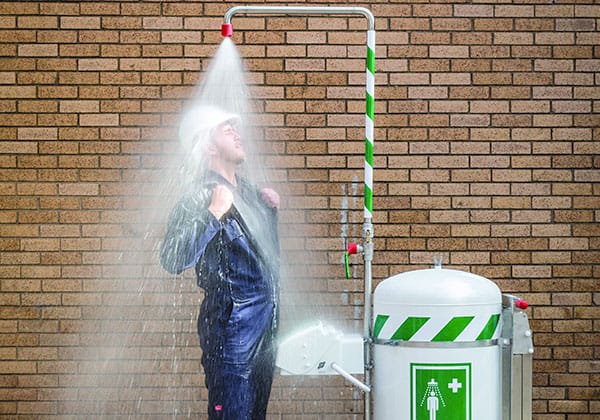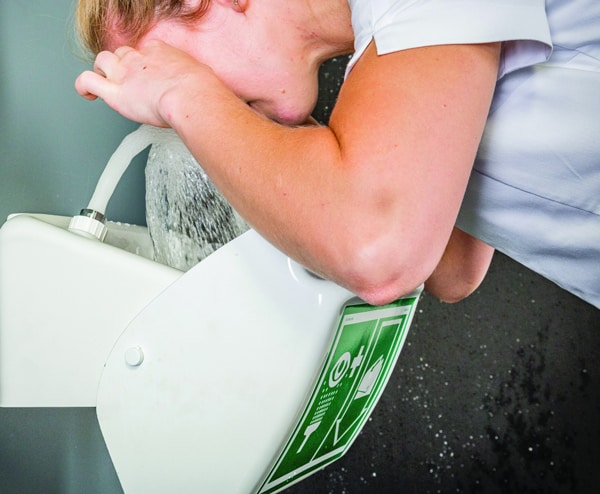In any workplace, ensuring the safety of employees is paramount. Among various safety measures, eye wash stations hold a crucial place, especially in environments where workers are exposed to hazardous substances. These stations are vital for immediate first aid in the event of eye exposure to chemicals, dust, or other irritants. This article delves into why eye wash stations are essential in workplace safety and how they contribute to overall eye protection and hygiene.
Why Eye Wash Stations Are Essential
Eye wash stations play a crucial role in maintaining workplace safety. They provide immediate first aid to individuals who have been exposed to harmful substances, which can include chemicals, dust, and other irritants. In environments such as laboratories, manufacturing plants, and construction sites, the risk of eye injuries is significantly higher, making the presence of these stations indispensable. They are designed to quickly flush out contaminants from the eye, minimizing the risk of severe injury and ensuring the well-being of employees.
Moreover, eye wash stations serve as a preventive measure, ensuring that minor incidents do not escalate into more serious health issues. By offering a rapid response solution, they help in reducing the overall impact of accidents. This immediate intervention can mean the difference between a minor irritation and a life-long impairment. Therefore, having eye wash stations readily available is not just a regulatory requirement but a critical component of a comprehensive workplace safety strategy.

Immediate Response to Eye Injuries
Eye injuries can happen unexpectedly and need immediate attention. The first few seconds after exposure to harmful substances are critical. Eye wash stations provide a quick and effective means to flush out contaminants, reducing the risk of long-term damage. Without immediate flushing, substances can cause severe irritation, burns, or even blindness.
The effectiveness of eye wash stations in mitigating damage is well-documented. They work by diluting and washing away harmful substances before they can penetrate deeper into the eye tissue. This immediate action is crucial in preventing severe complications such as chemical burns or permanent vision loss. Therefore, the presence of a well-maintained eye wash station can drastically reduce the severity of an eye injury.
Compliance with Safety Regulations
Many regulatory bodies mandate the presence of eye wash stations in workplaces where hazardous materials are handled. Compliance with these regulations not only ensures the safety of employees but also protects businesses from legal repercussions. Adhering to these guidelines demonstrates a company’s commitment to maintaining a safe working environment.
Ignoring these regulations can lead to severe penalties, including fines and shutdowns. Regulatory compliance also enhances the company’s reputation, portraying it as a responsible entity that prioritizes employee safety. In addition, it fosters a culture of safety and vigilance, encouraging employees to adhere to best practices and take personal responsibility for their safety and that of their colleagues.
Types of Eye Wash Stations
Eye wash stations come in various types, each designed to meet specific needs and circumstances in the workplace. Understanding the different types of stations available can help employers choose the most appropriate solutions for their specific environments. The three main categories are plumbed eye wash stations, portable eye wash stations, and combination showers and eye wash stations.
Plumbed Eye Wash Stations
Plumbed eye wash stations are connected to a constant water supply and are typically installed in fixed locations. They provide a steady flow of water and are ideal for facilities where hazardous materials are frequently handled. These stations are often found in laboratories, manufacturing plants, and chemical processing units.
The fixed nature of plumbed stations ensures that they are always ready for use, providing a reliable source of clean water. They are often equipped with features that allow for easy activation and continuous flow, ensuring that the affected area can be flushed thoroughly. Additionally, these stations can be integrated into existing plumbing systems, making them a convenient and effective solution for many workplaces.
Portable Eye Wash Stations
Portable eye wash stations are versatile and can be moved to different locations as needed. They are especially useful in temporary work sites or areas where plumbing is not available. These stations usually contain a saline solution that mimics natural tears, providing effective cleansing of the eyes.
The mobility of portable eye wash stations makes them ideal for dynamic work environments where the risk of eye injuries can shift from one area to another. They are easy to set up and can be placed strategically based on the specific needs of the task at hand. Their design often includes features like easy-to-use activation mechanisms and ergonomic handles for quick deployment.
Combination Showers and Eye Wash Stations
Combination units offer both eye wash and full-body drenching capabilities. These are essential in environments where workers are exposed to chemicals that can affect not just the eyes but also the skin. Combination units ensure comprehensive decontamination in case of exposure to harmful substances.
These stations are particularly beneficial in areas where large-scale chemical spills or accidents can occur. They provide an all-in-one solution, allowing for the rapid decontamination of both the eyes and the body. This dual functionality makes them indispensable in high-risk environments, ensuring that workers have access to immediate and comprehensive first aid.

Best Practices for Eye Wash Station Maintenance
Maintaining eye wash stations is as important as installing them. Regular inspections and testing ensure that the stations are functional and provide clean, uncontaminated water. Proper maintenance practices are essential to ensure that these life-saving devices are always ready for use in an emergency. Two key aspects of maintenance are regular inspection and testing, and ensuring clear signage and accessibility.
Regular Inspection and Testing
Maintaining eye wash stations is as important as installing them. Regular inspections and testing ensure that the stations are functional and provide clean, uncontaminated water. Weekly activation and annual maintenance checks are recommended practices to keep the stations in optimal condition.
Routine checks help identify potential issues such as blockages, contamination, or mechanical failures that could render the station ineffective. It’s crucial to follow a consistent inspection schedule, documenting each check to ensure compliance and facilitate future audits. Regular maintenance not only ensures the functionality of the stations but also extends their lifespan, providing a reliable safety measure for years to come.
Clear Signage and Accessibility
Eye wash stations should be easily accessible and clearly marked. In an emergency, workers should be able to locate and use the stations without delay. Clear signage and unobstructed pathways are crucial for quick access. Additionally, training employees on the proper use of eye wash stations can further enhance workplace safety.
Proper signage includes not only the location of the eye wash stations but also clear instructions on how to use them. This ensures that even in a state of panic, employees can quickly and efficiently operate the stations. Regular drills and educational sessions can help reinforce this knowledge, ensuring that all workers are familiar with the procedures and can act swiftly in an emergency.
Eye Protection: A Complementary Measure
While eye wash stations are vital for immediate response, preventing eye injuries in the first place is equally important. Personal protective equipment (PPE) like safety goggles, face shields, and helmets should be mandatory in hazardous work environments. These protective measures act as the first line of defense against potential eye injuries.
Implementing a robust PPE program involves not only providing the necessary equipment but also ensuring that it is used correctly and consistently. Employers should conduct regular assessments to identify potential hazards and ensure that the provided PPE meets the specific needs of their workplace. By combining PPE with eye wash stations, businesses can create a comprehensive safety net for their employees.
Selection of Appropriate Eye Protection
Choosing the right type of eye protection depends on the specific hazards present in the workplace. For instance, safety goggles are suitable for protection against chemical splashes, while face shields offer broader coverage against flying debris. Employers should assess the risks and provide appropriate PPE to their workers.
It’s important to consider factors such as comfort, fit, and compatibility with other protective gear when selecting eye protection. Employees are more likely to wear PPE consistently if it is comfortable and does not hinder their ability to perform their tasks. Regular training sessions can help workers understand the importance of using the right equipment and maintaining it properly.
Employee Training and Awareness
Training employees on the proper use of eye protection and the importance of eye hygiene is essential. Workers should be aware of the risks and know how to respond in case of an eye injury. Regular safety drills and informational sessions can reinforce the importance of eye protection and the use of eye wash stations.
Awareness campaigns can include posters, handouts, and digital resources that highlight the risks of eye injuries and the benefits of using PPE. By fostering a culture of safety, employers can encourage workers to take an active role in protecting their eyes. This proactive approach not only reduces the incidence of injuries but also enhances overall workplace morale and productivity.
The Role of Workplace Hygiene
Maintaining a clean and hygienic workplace reduces the risk of eye injuries and other health hazards. Regular cleaning of work areas, proper storage of hazardous materials, and ensuring that eye wash stations are free from contamination are crucial steps in promoting workplace hygiene. A clean environment minimizes the presence of irritants and contaminants that could potentially harm employees.
Implementing stringent hygiene protocols can significantly reduce the likelihood of accidents and exposure to harmful substances. This includes regular cleaning schedules, proper waste disposal methods, and ensuring that all safety equipment is kept in pristine condition. By prioritizing hygiene, employers can create a safer and more pleasant work environment for their employees.
Safe Handling and Storage of Hazardous Materials
Proper handling and storage of chemicals and other hazardous substances minimize the risk of accidental exposure. Employers should implement strict protocols for labeling, storing, and disposing of hazardous materials. Providing spill kits and training employees on spill response further enhances workplace safety.
Regular audits and inspections can help ensure that these protocols are being followed correctly. Employees should be trained to recognize potential hazards and know the steps to take in case of a spill or exposure. By maintaining a vigilant approach to the handling and storage of hazardous materials, businesses can prevent accidents and ensure a safer working environment.
Conclusion
Eye wash stations are an indispensable component of workplace safety. They provide immediate relief in the event of eye exposure to harmful substances, helping to prevent severe injuries and ensuring compliance with safety regulations. Along with eye wash stations, the use of appropriate eye protection and maintaining workplace hygiene are essential measures to safeguard employees’ health.
By prioritizing these safety practices, employers can create a safer work environment, reducing the risk of eye injuries and promoting overall well-being among workers. Remember, a safe workplace is not just a regulatory requirement but a commitment to the health and safety of every employee. Investing in safety measures like eye wash stations and PPE not only protects workers but also enhances productivity and morale, ultimately contributing to the success of the business.
Call to Action: Shop at Absorbents Online
As workplace safety continues to be a top priority, equip your environment with the best safety supplies available. At Absorbents Online, we offer a wide range of eye wash stations, personal protective equipment (PPE), and hygiene products tailored to meet the specific needs of your workplace. Don’t compromise on safety—visit our website today to explore our extensive selection, and ensure your team has the essential tools to protect their health. Act now and invest in safety for a safer, more productive work environment!